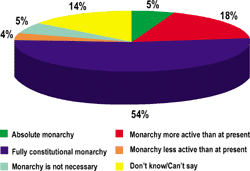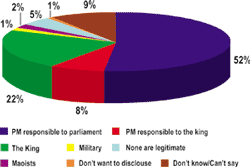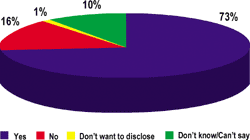 A nationwide public opinion poll has shown that the Nepali people overwhelmingly want a constitutional monarchy and parliamentary democracy-two provisions to which King Gyanendra reiterated his commitment during his royal proclamation two months ago.
A nationwide public opinion poll has shown that the Nepali people overwhelmingly want a constitutional monarchy and parliamentary democracy-two provisions to which King Gyanendra reiterated his commitment during his royal proclamation two months ago.
The poll, conducted by Interdisciplinary Analysts with AC Nielsen in 35 sample districts, was taken before February First and reflects the national mood just before the king sacked the government and imposed emergency rule.
Most of the 3,059 respondents felt that although a system in which political parties answerable to parliament is the most legitimate form of government they faulted the parties and their leadership.  Interestingly, only five percent wanted the king to have absolute powers and the same proportion were for a republic. Most felt that the Maoist insurgency should be settled through negotiations, but they distrusted both the Deuba government (which was in power in December) and the Maoist leadership, preferring third party mediation by human rights groups or the UN.
Interestingly, only five percent wanted the king to have absolute powers and the same proportion were for a republic. Most felt that the Maoist insurgency should be settled through negotiations, but they distrusted both the Deuba government (which was in power in December) and the Maoist leadership, preferring third party mediation by human rights groups or the UN.
The most interesting revelation in the poll was that a very small proportion of people knew or understood what the constituent assembly demand of the Maoists entailed and only ten percent actually wanted it (see box, p4). Restoring parliament also received low priority, with only ten percent favouring it.  Even though some of the results many appear contradictory especially regarding the ways to overcome the present stalemate, the Nepali people seem to want an overall political framework in which the
Even though some of the results many appear contradictory especially regarding the ways to overcome the present stalemate, the Nepali people seem to want an overall political framework in which the
constitutional monarchy, parliamentary democracy and the Maoists all fit in.
By disagreeing with the demand of the political parties for restoration of the house, the Maoist demand for constituent assembly and their preference for a constitutional monarchy, the people are sending ar message that they want all three forces to come together and resolve differences.  Conclusions of past public opinion surveys in this country (Nepali Times, #38, #115, #140, #218) have proven time and again that the people have a great deal more wisdom than they are given credit for. They are pragmatic, not swayed by slogans and extremism, they have their priorities well figured out, and they know who the crooks are.
Conclusions of past public opinion surveys in this country (Nepali Times, #38, #115, #140, #218) have proven time and again that the people have a great deal more wisdom than they are given credit for. They are pragmatic, not swayed by slogans and extremism, they have their priorities well figured out, and they know who the crooks are.
An overwhelming majority of Nepalis still favour a democratic government. In spite of everything that has gone wrong in the past 15 years, they don't blame the system. They do identify specific disadvantages of democracy, and in order of priority, they are: misuse of power by those who wield it, corruption, politicians forgetting constituencies after being elected, politicisation of the administration and continuous protests by opposition parties.
Despite these drawbacks, they say the two most important advantages of democracy are: freedom of expression and the right to elect rulers.  The people overwhelmingly reject republicanism and an absolute monarchy, and if the proportion of those undecided on the role of the monarchy (14 percent) is excluded, support for constitutional monarchy becomes 63 percent. However, there is an age and education factor in responses. People above 56 and the less educated seem to be the one ones most in favour of a more active monarchy. Most with college education or higher favour a fully constitutional monarchy, although it is in this age group that republicanism has the most adherents.
The people overwhelmingly reject republicanism and an absolute monarchy, and if the proportion of those undecided on the role of the monarchy (14 percent) is excluded, support for constitutional monarchy becomes 63 percent. However, there is an age and education factor in responses. People above 56 and the less educated seem to be the one ones most in favour of a more active monarchy. Most with college education or higher favour a fully constitutional monarchy, although it is in this age group that republicanism has the most adherents.  On the Maoist insurgency, most respondents felt the priority should be for negotiations. They reject options like suppressing the Maoists militarily and strongly believe that the ongoing conflict can't be resolved by military means. They blame the failure of past negotiations on the lack of flexibility on the part of the government and the Maoists. Three-fourths of the respondents believe the conflict can be settled through negotiations. A significant number favoured third party mediation by the UN (20 percent) human rights organizations (25 percent).
On the Maoist insurgency, most respondents felt the priority should be for negotiations. They reject options like suppressing the Maoists militarily and strongly believe that the ongoing conflict can't be resolved by military means. They blame the failure of past negotiations on the lack of flexibility on the part of the government and the Maoists. Three-fourths of the respondents believe the conflict can be settled through negotiations. A significant number favoured third party mediation by the UN (20 percent) human rights organizations (25 percent).
Sudhindra Sharma and Pawan Kumar Sen
The nationwide Contemporary Political Situation in Nepal opinion poll was conducted by Interdisciplinary Analysts and ACNielsen and funded by The Asia Foundation. A closed-ended questionnaire was administered on 3,059 respondents in 35 sample districts in November and December 2004. Eleven field supervisers and 48 enumerators took part.
Full report will be available after 30 March, ida@wlink.com

Constituent what?
Despite the debate in the media about the Maoist demand for elections to a constituent assembly, only half the Nepalis may have heard of the term. Among those who have heard of it, half claim that they understand what it means. But in reality only half of those who claim to know what it is actually understand the concept correctly. All in all, less than 15 percent of Nepalis understand what a constituent assembly is all about.
Predictably, there seems to be a correlation between education level and position on constituent assembly with university students showing the most support for it. Also, those younger than 45 were much more open to the idea than older age groups.


